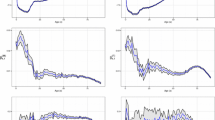Abstract
Projected life tables are obtained from forecasting methods and account for future improvements in longevity. Since the future path of mortality is unknown, working with projected life tables makes the survival probabilities stochastic. The resulting demographic indicators in turn become random variables. This paper aims to study the distribution of period and cohort life expectancies derived from projected life tables. To fix the ideas, we adopt here the standard Lee–Carter framework, where the future forces of mortality are decomposed in a log-bilinear way. Exact formulas are derived for period life expectancies, and approximations are proposed for cohort life expectancies. In the latter case, numerical illustrations based on Belgian population data show that the relative accuracy is remarkable.
Similar content being viewed by others
References
Booth H (2006). Demographic forecasting: 1980 to 2005 in review. Int J Forecast 22: 547–581
Brouhns N, Denuit M and Keilegom I (2005). Bootstrapping the Poisson log-bilinear model for mortality projection. Scand Act J 2005: 212–224
Brouhns N, Denuit M and Vermunt JK (2002). A Poisson log-bilinear approach to the construction of projected lifetables. Insur Math Econ 31: 373–393
Brouhns N, Denuit M and Vermunt JK (2002). Measuring the longevity risk in mortality projections. Bull Swiss Assoc Actuaries 2002: 105–130
Denuit M and Dhaene J (2007). Comonotonic bounds on the survival probabilities in the Lee–Carter model for mortality projections. Comput Appl Math 203: 169–176
Denuit M, Frostig E (2007) Prudential rules for life annuity pricing and reserving. Institut des Sciences Actuarielles, Université Catholique de Louvain, Louvain-la-Neuve, Belgium, Memo 07-02
Denuit M, Dhaene J, Goovaerts MJ and Kaas R (2005). Actuarial theory for dependent risks: measures, Orders and Models. Wiley, New York
Dhaene J, Denuit M, Goovaerts MJ, Kaas R and Vyncke D (2002). The concept of comonotonicity in actuarial science and finance: theory. Insur Math Econ 31: 3–33
Dhaene J, Denuit M, Goovaerts MJ, Kaas R and Vyncke D (2002). The concept of comonotonicity in actuarial science and finance: applications. Insur Math Econ 31: 133–161
Koissi MC, Shapiro AF and Högnäs G (2006). Evaluating and extending the Lee–Carter model for mortality forecasting: bootstrap confidence intervals. Insur Math Econ 38: 1–20
Lee RD (2000). The Lee–Carter method of forecasting mortality, with various extensions and applications. North Am Actuar J 4: 80–93
Lee RD and Carter L (1992). Modelling and forecasting the time series of US mortality. J Am Stat Assoc 87: 659–671
Pitacco E (2004). Survival models in a dynamic context: a survey. Insur Math Econ 35: 279–298
Wong-Fupuy C and Haberman S (2004). Projecting mortality trends: recent developments in the United Kingdom and the United States. North Am Actuar J 8: 56–83
Author information
Authors and Affiliations
Corresponding author
Rights and permissions
About this article
Cite this article
Denuit, M. Distribution of the random future life expectancies in log-bilinear mortality projection models. Lifetime Data Anal 13, 381–397 (2007). https://doi.org/10.1007/s10985-007-9040-6
Received:
Accepted:
Published:
Issue Date:
DOI: https://doi.org/10.1007/s10985-007-9040-6




